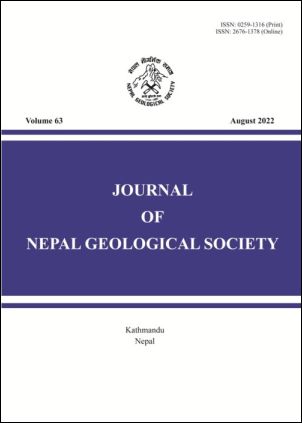Qualitative rock-fall hazard mapping around the Siddhababa area along the Siddhartha Highway in western Nepal
DOI:
https://doi.org/10.3126/jngs.v63i01.50843Keywords:
Siwalik, rock-fall, susceptible, hazard, failure, kinematic analysisAbstract
The Butwal-Dobhan road section of the Siddhartha Highway is highly hazardous and problematic section due to rock-fall. In this road section, the Siwalik rocks are exposed that contains inter-bedding of hard and soft rocks. The differential weathering pattern of hard rock sandstone and soft rock mudstone exhibit different properties in the presence of water. Mudstone can easily be softened by water and flow down as slurries when saturated, whereas sandstone cannot easily be softened in water resulting overhanging of sandstone and finally dislodges rock blocks as a rock-fall. The main aims of this study are to investigate and understand the causes of rock-fall, to prepare rock-fall hazard map and ultimately to protect people, properties, man-made structures and to spread public awareness against rock-fall problem. For these set objectives, the study area is divided into twenty-three zones based on segment length along the highway, topography and orientation of discontinuities. Two bases are used to collect field data; one is the rock classification basis viz. rock quality designation, rock mass rating, geological strength index, and slope mass rating, and another basis is kinematic analysis viz. planar sliding, planar sliding no limit, wedge sliding, flexural toppling and direct toppling. The collected data are rated and prepared individual susceptible values. Finally, combining the entire individual’s susceptible values along with topographic mosaic, final hazard map was prepared where five different hazard zones have been identified and are categorized into very low, low, medium, high and very high hazard zones. Results from the study could be used as the preliminary study for hazard assessment and land use planning, and to disseminate public awareness.
Downloads
Downloads
Published
How to Cite
Issue
Section
License
© Nepal Geological Society




